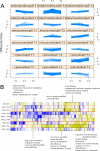Significance analysis of spectral count data in label-free shotgun proteomics
- PMID: 18644780
- PMCID: PMC2596341
- DOI: 10.1074/mcp.M800203-MCP200
Significance analysis of spectral count data in label-free shotgun proteomics
Abstract
Spectral counting has become a commonly used approach for measuring protein abundance in label-free shotgun proteomics. At the same time, the development of data analysis methods has lagged behind. Currently most studies utilizing spectral counts rely on simple data transforms and posthoc corrections of conventional signal-to-noise ratio statistics. However, these adjustments can neither handle the bias toward high abundance proteins nor deal with the drawbacks due to the limited number of replicates. We present a novel statistical framework (QSpec) for the significance analysis of differential expression with extensions to a variety of experimental design factors and adjustments for protein properties. Using synthetic and real experimental data sets, we show that the proposed method outperforms conventional statistical methods that search for differential expression for individual proteins. We illustrate the flexibility of the model by analyzing a data set with a complicated experimental design involving cellular localization and time course.
Figures





References
-
- Domon, B., and Aebersold, R. ( 2006) Mass spectrometry and protein analysis. Science 312, 212–217 - PubMed
-
- Nesvizhskii, A. I., Vitek, O., and Aebersold, R. ( 2007) Analysis and validation of proteomic data generated by tandem mass spectrometry. Nat. Methods 4, 787–797 - PubMed
-
- Gygi, S. P., Rist, B., Gerber, S. A., Turecek, F. Gelb, M. H., and Aebersold, R. ( 1999) Quantitative analysis of complex protein mixtures using isotope-coded affinity tags. Nat. Biotechnol. 17, 994–999 - PubMed
-
- Ong, S. E., Blagoev, B., Kratchmarova, I., Kristensen, D. B., Steen, H., Pandey, A., and Mann, M. ( 2002) Stable isotope labeling by amino acids in cell culture, SILAC, as a simple and accurate approach to expression proteomics. Mol. Cell. Proteomics 1, 376–386 - PubMed
-
- Ross, P. L., Huang, Y. N., Marchese, J. N., Williamson, B., Parker, K., Hattan, S., Khainovski, N., Pillai, S., Dey, S., Daniels, S., Purkayastha, S., Juhasz, P., Martin, S., Bartlet-Jones, M., He, F., Jacobson, A., and Pappin, D. J. ( 2004) Multiplexed protein quantitation in Saccharomyces cerevisiae using amine-reactive isobaric tagging reagents. Mol. Cell. Proteomics 3, 1154–1169 - PubMed
Publication types
MeSH terms
Substances
Grants and funding
LinkOut - more resources
Full Text Sources
Other Literature Sources
Molecular Biology Databases

